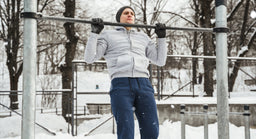
How To Use Mace Bells For The Ultimate Unconventional Training
Unconventional training is making a name for itself, not just in functional fitness circles but in big box gyms and home workouts. If you’re new to this style of training, or want to add mace bells to your equipment list, we’ve got you covered.
What Is Unconventional Training?
Unconventional training and functional fitness are different things, but they overlap. You could say that unconventional training styles help develop functional fitness better than any other kind of training.
Unconventional training is exactly what it sounds like – any form of strength training and conditioning work that is not done with traditional machines, barbells, or dumbbells. Unconventional training is not isolation work. It challenges different movements, raises your heart rate, and gets you moving in a functional way under load.
The most popular forms of unconventional training includes kettlebell training, battle ropes, gymnastics rings and parallettes. But there’s much more to unconventional training than these tools. Have you ever trained with slam balls, sandbags, tyres, or mace bells? They’re all great examples of unconventional training tools.
If you can drag it, load it, pull it, or throw it – it’s probably an unconventional training tool.
Mace Bells Unconventional Training Tool
You won’t find mace bells (or steel mace) in many gyms, which is a shame because it’s one of the most adaptable and effective unconventional tools you can use. Like kettlebells, mace bells have a long and noble history in ancient tradition.
Today’s mace bells are an amazing full body training tool. Most of the weight is in the head of the mace bell, making the load feel uneven, challenging all your small stabiliser muscles. Fantastic for grip strength, shoulder health, core strength, fat burning, and conditioning.
How To Use Mace Bells
Mace Bells are similar to kettlebells in that you can swing, lift, and press them in a variety of different movements. You can also combine exercises in a long flow, making the mace bell a great cardio and conditioning tool.
7 Mace Bell Exercises To Try
Alternate hand switches – get used to changing the mace from left hand to right hand and back again (similar to a kettlebell swing).
Pendulum – put the mace behind your back so it is hanging down the length of your spine, and hold it at the top behind your neck. Get used to swinging it like a pendulum in this position, with your scapula retreated and elbows tucked.
Metronome – hold the mace in front of you, with both hands at the bottom of the mace (at your naval). Move the mace side to side from the 10-2 position. Don’t let it move out from your body but don’t let it touch your body either.
Mace 360 – start with the mace at the vertical front position, hands stacked at the bottom near your naval. Swing the mace over one shoulder, across your back, and over your other shoulder. You can progress to doing 360s single-handed.
Mace lunge – hold the mace bell in front of you in a horizontal position (both hands facing palms up). Perform alternate forward lunges.
Pull-through plank – get into a plank position above the mace, and pull it through underneath your body to challenge your core stability.
Mace bell row – use your mace bell to perform bent-over rows, you’ll find that the offset nature of the weight will challenge each side of your posterior chain differently.
5 Benefits Of Mace Bells Training
• Conditioning and fat burn
• Improved shoulder mobility
• Rotational strength
• Serious core stability
• Balance and coordination
































